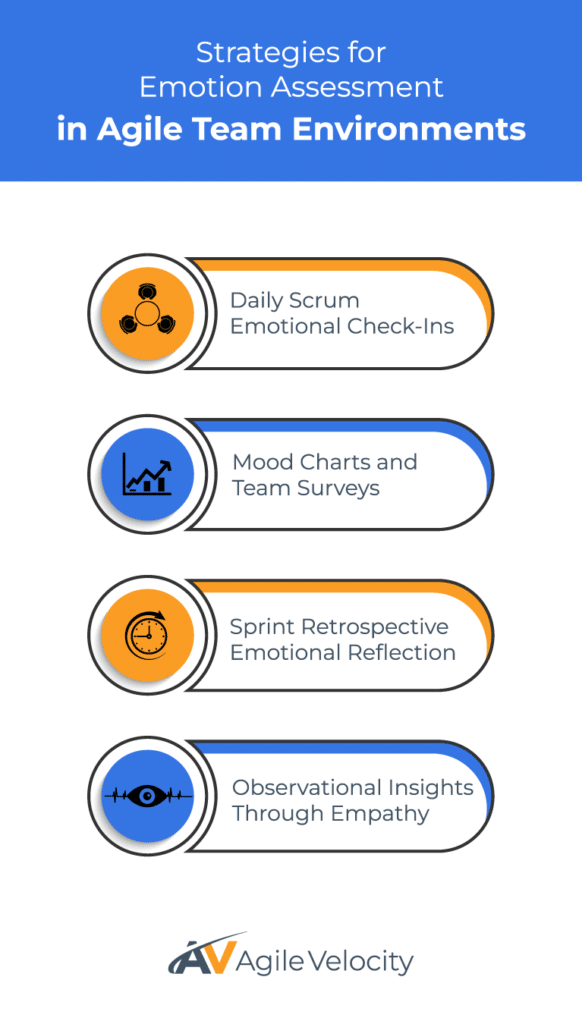Agile teams flourish through collaboration, adaptability, and continuous improvement, but there’s a crucial and often overlooked component that significantly impacts a team’s success: emotional well-being. The way team members feel daily influences creativity, decision-making, and achieving Sprint Goals. When emotions are ignored, productivity can falter, and communication breaks down.
In this article, we’ll explore how incorporating emotion measurement and assessment tools into Agile frameworks can enhance collaboration, uncover hidden challenges, and empower teams to reach new levels of success. We’ll also examine how emotional awareness supports Agile Transformations and accelerates continuous improvement, ensuring your teams thrive in dynamic environments.
The Importance of Emotional Well-Being in Agile Team Performance
Emotional well-being is a vital yet often underestimated factor in Agile team performance. It directly influences how team members collaborate, solve problems, and respond to change. In Agile frameworks, where adaptability and open communication are core principles, maintaining positive team emotions is essential for achieving Sprint Goals and fostering continuous improvement.
Positive emotional climates in Agile teams lead to:
- Stronger trust: Members feel confident and safe sharing ideas, fostering unity.
- Healthier team dynamics: Open communication and smoother conflict resolution help teams address problems efficiently.
- Faster adaptation: Teams can pivot during Sprint Planning or Daily Scrums without losing focus.
Conversely, ignoring emotions can lead to misalignment, friction, and missed objectives. Teams facing emotional challenges often experience conflicts, poor communication, and diminished motivation, eroding cohesion and delaying progress.
Build High-Performing Teams
Linking Emotional Well-Being to Agile Transformations
In Agile Transformations, emotional well-being plays an important role. Transforming an organization to Agile requires transparency, openness to feedback, and an innovative mindset—all thriving when emotional security is prioritized.
Psychological safety, the ability to express thoughts without fear of judgment, is essential for successful transformations. Emotions signal potential roadblocks or growth opportunities, enabling teams to embrace the iterative process fundamental to Agile success.
Organizations focusing solely on deadlines or costs often overlook the emotional context driving performance. Actively addressing emotional well-being allows leaders to align teams more effectively on Sprint Goals and sustain momentum for continuous improvement, making emotional prioritization a strategic approach for long-term Agile team performance and success.
The Impact of Emotions on Team Performance in Agile Environments
Emotions significantly shape the productivity and success of Agile teams. Positive emotions like enthusiasm and mutual respect enhance collaboration, clarify priorities, and support adaptability. Unaddressed negative emotions, such as frustration or anxiety, create barriers that interfere with performance and derail progress.
Common Emotional Challenges in Agile Teams
Agile environments often involve fast-paced, high-stakes conditions that trigger a range of emotions:
- Deadline-driven anxiety: Pressure to meet Sprint Goals can lead to stress and overcommitment.
- Fear of failure: Teams may shy away from experimentation if errors are stigmatized.
- Frustration from ambiguity: Unclear requirements or shifting priorities can spark conflict and erode motivation.
Failing to address these emotional obstacles results in declining collaboration, tension, and missed objectives—weakening team resilience and overall performance.
The Hidden Costs of Ignoring Emotions
Ignoring emotional issues undermines key Agile principles of self-organization and openness. Persistent friction reduces knowledge sharing, diminishes trust, and leads to slowed progress. Long-term consequences include high turnover and decreased innovation. Addressing emotions early fosters sustained motivation, enabling teams to handle obstacles head-on and maintain high performance.
Understanding Emotion Measurement in Agile Contexts
Emotion measurement involves gathering insights into the emotional states of team members, helping everyone see how emotions influence collaboration, decision-making, and performance. Methods range from informal daily feedback to structured data collection, translating team emotions into actionable insights.
Why Track Emotions?
Tracking emotions isn’t just about making people feel good—it’s about enabling your team to perform at its best:
- Proactive problem solving: Detecting declines in morale helps address issues before they disrupt Sprint Goals or velocity.
- Improved engagement: Teams that feel heard and supported remain more productive, creative, and satisfied.
- Strengthened transparency: Emotional visibility aligns with Agile values of openness, making it easier to drive improvement.
Alignment With Agile Frameworks
Measuring emotions fits seamlessly into common frameworks like Scrum, Kanban, and SAFe®:
- Scrum: Check-ins during Daily Scrums or Sprint Retrospectives can surface emotional insights.
- Kanban: Real-time feedback on emotional states optimizes flow.
- SAFe: Large-scale initiatives benefit from team awareness, guiding better decision-making.
Key Techniques for Measuring and Assessing Emotions in Agile Teams
Unlocking the full potential of Agile team performance requires a deep understanding of emotional dynamics. The section explores innovative strategies that integrate emotion assessment seamlessly into Agile practices, enhancing Agile team performance and fostering a resilient, collaborative environment. Discover how these techniques can transform emotional insights into actionable strategies for sustainable success.


Daily Scrum Emotional Check-Ins
Include a brief prompt such as, “How is everyone feeling about our progress?” at the start or end of Daily Scrums. This reveals concerns or positive energy, encouraging honest communication.
Mood Charts and Team Surveys
Use visual tools like mood charts or short surveys to gauge team emotions. Identifying patterns helps Scrum Masters and leaders address emerging issues quickly.
Sprint Retrospective Emotional Reflection
Prompt the team to discuss how emotions influenced the Sprint. This can uncover blockers, boost self-awareness, and spark continuous improvement initiatives.
Observational Insights Through Empathy
Scrum Masters and Team Leads can look for subtle cues—changes in tone or body language—to detect shifts. A timely conversation often prevents bigger issues from growing.
How Emotional Well-Being Enhances Agile Team Performance
Prioritizing emotional well-being fuels Agile success and enhances Agile team performance by building trust, fostering collaboration, and removing productivity barriers.
Enhancing Collaboration
Teams that communicate openly about emotions can address problems quickly. This amplifies cooperation and innovation, preventing small concerns from escalating.
Building Trust and Transparency
Addressing emotions head-on supports psychological safety. When people feel safe sharing thoughts, the team adapts to change with fewer setbacks.
Simplifying Workflows and Elevating Deliverables
Emotionally aware teams spot—and resolve—emotional blockers early, maintaining focus on delivering value. This leads to better outcomes aligned with Sprint Goals.
Fostering Resilience During Change
Agile teams often face frequent shifts in priorities. Emotional well-being provides a stable foundation, helping teams adapt gracefully without sacrificing performance.
Empowering Leaders to Elevate Organizational Agility
Leaders play a key role in Agile team performance by modeling empathy, building trust, and integrating emotional insights into decisions. By valuing well-being alongside productivity, organizations realize sustainable Agile team performance.
12 Actionable Tips for Integrating Emotion Measurement into Agile Workflows
Implementing emotion measurement into Agile workflows can transform team dynamics and enhance performance. By adopting practical strategies like daily emotional check-ins and mood tracking, Agile teams can foster a more transparent, resilient, and collaborative environment, ultimately aligning team well-being with productivity and continuous improvement. Explore the following tips to seamlessly incorporate emotional awareness into your Agile practices and elevate team success.
- Include quick check-ins: Start Daily Scrums with a brief emotional prompt.
- Use Retrospectives for deeper reflection: Ask how emotions affected outcomes.
- Normalize feedback: Lightweight tools like surveys and mood charts make emotional data easy to gather. Present them as tools for better collaboration.
- Build psychological safety: Show that emotional input is welcomed. Remember to treat emotions as data, not distractions.
- Train leaders: Equip them with empathy and observation skills to guide open discussions.
- Analyze trends: Use emotional assessment data to inform decisions about workload and processes.
- Keep it simple: Consistency beats complexity when introducing new practices.
- Address skepticism: Show how improved emotional health reduces turnover and boosts productivity.
- Set emotional benchmarks: Track improvements over time and celebrate positive shifts. Monitor the trends and correlate major organizational changes with morale fluctuations.
- Schedule regular reviews: Compare emotional data with Agile performance metrics, incorporating continuous improvement.
- Adapt continuously: Refine methods based on team feedback and changing dynamics to stay aligned with Agile values.
- Integrate emotional goals: Treat emotional well-being as a core measure of team strength and readiness.
Leadership’s Role in Supporting Emotional Well-Being in Teams

Leadership plays a pivotal role in steering Agile team performance by fostering emotional well-being. This section delves into how leaders can cultivate an environment of empathy and trust, enabling their teams to navigate challenges and adapt to changes with resilience. Discover the strategies leaders can employ to prioritize emotional health, thereby enhancing overall team performance and sustaining long-term Agile success.
Lead by Example
Leaders should model emotional awareness, addressing conflicts constructively and encouraging openness. When leadership displays vulnerability, it sends a message of trust and respect that resonates with Agile teams.
Build a Culture of Trust
Foster an inclusive culture by recognizing that emotional insights are valuable data points. Acknowledge emotional input during events, showing genuine interest in team well-being. This approach aligns with the core values of collaboration and ownership, which thrive in supportive environments.
Advocate for Emotional Awareness Across the Organization
Encourage emotional check-ins during broader planning sessions, embedding emotional well-being in the company’s culture. This not only improves daily interactions but also strengthens decision-making during more complex discussions about portfolio management or strategic initiatives.
Leverage Emotional Data in Decision-Making
Combine emotional data with performance metrics to manage workload and resources without compromising well-being or Agile principles. This holistic outlook helps leaders maintain balanced teams and sustain high-quality deliverables, underscoring the benefits of open communication.
Empower Teams With Supportive Leadership
Equip Scrum Masters and Agile Coaches with facilitation skills to embed emotional well-being into everyday Agile practices. When teams know their leaders genuinely care about emotional states, disruptive challenges can be tackled faster and more efficiently.
Be the Leader Your Team Needs
Elevate Agile Success Through Emotional Intelligence
Emotional well-being is essential for Agile team performance. By prioritizing emotional awareness and incorporating tools to measure and address emotions, teams build trust, openness, and collaboration. This enables smoother adaptation to challenges, effective resolution of blockers, and stronger outcomes in achieving Sprint Goals.
Integrating emotion measurement into Agile practices unlocks the full potential of teams, fostering transparency and continuous improvement through deeper emotional intelligence. At Agile Velocity, we understand the power of emotional awareness in transforming teams and driving successful Agile Transformations. Our tailored solutions empower your organization to balance speed, quality, and well-being at scale. Ready to elevate your business dynamics and Agile team performance? Reach out today to explore how we can help nurture an emotionally supportive environment for lasting success.



